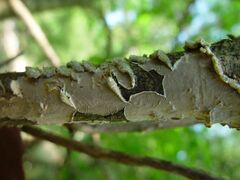Biology:Lopharia
| Lopharia | |
|---|---|

| |
| Fruitbody of the resupinate fungus Lopharia spadicea | |
| Scientific classification | |
| Kingdom: | |
| Division: | |
| Class: | |
| Order: | |
| Family: | |
| Genus: | Lopharia Kalchbr. & MacOwan (1881)
|
| Type species | |
| Lopharia lirellosa Kalchbr. & MacOwan (1881)
| |
Lopharia is a genus of fungi in the family Polyporaceae. The genus was circumscribed by Károly Kalchbrenner and Peter MacOwan in 1881.[1]
Description
Fruit bodies of Lopharia fungi are crust like, to effused-reflexed (like a crust with the edges curled out to form caps). The sterile portion of the crust surface is tomentose, while the spore-bearing surface (the hymenium) is smooth or tuberculate. The colour ranges from greyish-white to cream to pale yellowish.[2]
Lopharia has a dimitic hyphal system, meaning that it contains both generative and skeletal hyphae. The generative hyphae have clamp connections. Basidia are club shaped with four sterigmata, and have a clamp at the base. Spores are cylindrical to ellipsoid in shape with a smooth surface. They are hyaline (translucent), and have oily contents.[2]
Species
A 2008 estimate placed 13 species in Lopharia.[3] (As of May 2021), Index Fungorum accepts 15 species:[4]
- Lopharia albida Rick (1938)[5]
- Lopharia americana Rick (1928)[6]
- Lopharia amethystea (Hjortstam & Ryvarden) A.L.Welden (2010)
- Lopharia bambusae Rick (1960)[7]
- Lopharia cinerascens (Schwein.) G.Cunn. (1956)
- Lopharia cystidiosa (Rehill & B.K.Bakshi) Boidin (1969)
- Lopharia javanica Henn. & E.Nyman (1900)[8]
- Lopharia lilacina (Berk. & Broome) A.L.Welden (2010)
- Lopharia ochracea G.Cunn. (1963)[9]
- Lopharia papyracea (Bres.) D.A.Reid (1957)[10]
- Lopharia papyrina (Mont.) Boidin (1959)
- Lopharia pilosiuscula (Hjortstam & Ryvarden) A.L.Welden (2010)
- Lopharia pseudocinerascens Boidin & Gilles (2003)[11]
- Lopharia rimosissima Rick (1960)[7]
- Lopharia rugulosa (Berk. & M.A.Curtis) Hjortstam (1995)
References
- ↑ Kalchbrenner, C. (1881). "Fungi MacOwaniani" (in Latin). Grevillea 10 (54): 52–59. http://www.cybertruffle.org.uk/cyberliber/59649/0010/054/0052.htm.
- ↑ 2.0 2.1 Bernicchia, A.; Gorjón, S.P. (2010). Fungi Europaei – Corticiaceae s.l.. 12. Edizioni Candusso. p. 426. ISBN 978-8890105791.
- ↑ Kirk, P.M.; Cannon, P.F.; Minter, D.W.; Stalpers, J.A. (2008). Dictionary of the Fungi (10th ed.). Wallingford, UK: CAB International. p. 392. ISBN 978-0-85199-826-8.
- ↑ Kirk PM.. "Species Fungorum (version 28th September 2016). In: Species 2000 & ITIS Catalogue of Life". http://www.catalogueoflife.org/col/browse/tree/id/d23a3b468ff2c5e4432a2f5ffbc9baf7. Retrieved 2016-10-29.
- ↑ Rick, J. (1938). "Monografia das poliporineas Riograndenses". Brotéria Série Trimestral: Ciências Naturais 7: 5–21.
- ↑ Rick, J.E. (1928). "Resumo mycologico". Egatea 13: 432–439.
- ↑ 7.0 7.1 Rick, J. (1960). "Basidiomycetes Eubasidii in Rio Grande do Sul Brasilia. 4. Meruliaceae, Polyporaceae, Boletaceae". Iheringia 7: 193–295.
- ↑ Hennings, P. (1900). "Fungi monsunenses". Monsunia 1: 137–174 (see p. 144).
- ↑ Cunningham, G.H. (1963). The Thelephoraceae of Australia and New Zealand. Bulletin of the New Zealand Department of Industrial Research. 145. p. 332.
- ↑ Reid, Derek A. (1957). "New or interesting records of Australasian Basidiomycetes. III". Kew Bulletin 12 (1): 127–143. doi:10.2307/4109115.
- ↑ Boidin, J.; Gilles, G. (2002). "À propos du genre Lopharia sensu lato (Basidiomycètes, Aphyllophorales)" (in French). Bulletin de la Société Mycologique de France 118 (2): 91–115.
Wikidata ☰ Q8009469 entry
 |

